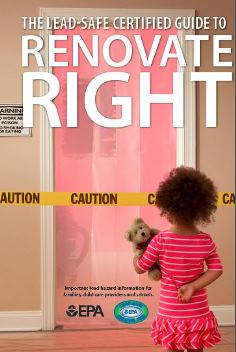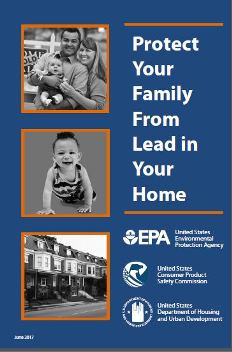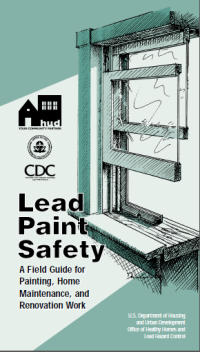Lead poisoning can be prevented – as long as homeowners know how to reduce or eliminate exposure to lead dust and deteriorated lead paint and what danger signs to look for.
Ways to Keep Your Home Lead Safe
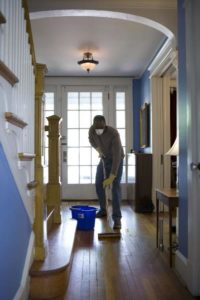 Keep the paint in your home in good condition.
Keep the paint in your home in good condition.
- Make sure children are out of the room when you do touch up work.
- Protect yourself by wearing proper protective gear and protect your family by working lead safe. Make sure you clean the work area, yourself, and your tools so you don’t move lead dust around.
- Take care of any water leaks or moisture problems in your apartment. Moisture can cause paint to break down faster.
- Cover areas with peeling paint or plaster with duct tape or contact paper until it can be repaired by a lead-safe certified contractor.
- If hiring a professional to do renovations, repairs, painting on a home building before 1978 be sure to hire a lead-safe certified contractor. It’s the law!
Keep your home clean.
- Cleaning regularly will help you reduce your exposure to lead in paint, dust, and soil.
- Clean or remove shoes or use a doormat before entering your home to prevent tracking in soil that may contain lead.
- Wet clean floors and other areas in your home that are more likely to gather lead dust, such as windows, stair treads, doors, and door frames. Use a mop or sponge with warm water and a general all-purpose cleaner or a lead-specific cleaning agent. Educate yourself on lead-safe cleaning methods. Lead dust cannot safely be cleaned up by traditional cleaning methods, such as sweeping or vacuuming with an ordinary vacuum cleaner.
- Vacuum carpeted areas with a HEPA vacuum to remove lead paint chips and flakes.
Use cold tap water for drinking and cooking.
- Run water until it feels cold before using.
Identify potential sources of lead in and around your home.
- Lead can be found in many places in your apartment, such as in peeling and chipping lead paint, dust from lead paint, soil in your yard, tap water from lead pipes or lead solder, pottery, crystal, ceramic dishes, and toys.
- If you see chipping or peeling paint inside your home, immediately wet clean any paint chips or dust using lead-safe cleaning methods and cover areas with peeling paint or plaster with duct tape or contact paper until it can be repaired. If you hire a professional contract to make repairs be sure to hire a lead-safe certified contractor. It’s the law!
Learn more about antiques as a potential source of lead in your home.
Renovating, Repairing, or Painting Your Home
In 2010, the U.S. Environmental Protection Agency’s (EPA’s) Renovation, Repair, and Painting (RRP) rule went into effect. The EPA’s RRP rule requires contractors who work on homes built before 1978 to be trained and certified in using lead-safe work practices. If painting and home improvement activities disturb lead paint, they can create a lead hazard by producing pain dust, chips, or fumes which can poison family members, visitors, and neighbors. Lead dust cannot safely be cleaned up by traditional cleaning methods, such as sweeping or vacuuming with an ordinary vacuum cleaner.
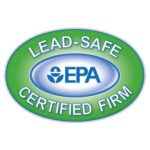 Home repairs that create even a small amount of lead dust are enough to harm your child. To protect your family, if you live in a house or apartment that was built before 1978, make sure you hire a contractor who is Lead-Safe Certified. Visit the EPA’s website to find a Lead-Safe Certified Contractor in your area or call 800-424-LEAD-FREE.
Home repairs that create even a small amount of lead dust are enough to harm your child. To protect your family, if you live in a house or apartment that was built before 1978, make sure you hire a contractor who is Lead-Safe Certified. Visit the EPA’s website to find a Lead-Safe Certified Contractor in your area or call 800-424-LEAD-FREE.
Protect Your Family – Look for the Lead Safe Logo!
Testing Your Home or Property for Lead Hazards
There are several options for testing your home for lead hazards.
- Household Lead Test Kit: You can buy kits, such as 3M’s LeadCheck Swabs ®, at a hardware store. However, these kits will not tell you if there is lead paint covered by a layer of non-leaded paint.
- Lead Dust Tests: Simple and quick kits can identify if there is a lead dust problem in your home.
- Soil Tests: You may want to test areas near your home where your children play or the soil in your garden.
- Water Tests: Public water supplies are tested for lead. You can contact them to find out the test results. You can also get your water tested for lead on you own, which is especially important if your water comes from a private well.
- Professional Lead Inspectors: You can hire a professional lead inspector to test your home. A professional inspector will be able to measure lead in paint, even if it is covered. They can also test your soil, dust, and water for lead.
Learn more about testing for lead hazards.
Eliminating Lead Hazards in Your Home
There are several methods that can be used to eliminate lead hazards in your home. Repainting is not a permanent solution but may reduce lead exposure. In addition, lead-painted objects can be replaced with lead-free replacements (e.g., doors, window casings, moldings, and trim). Consider permanently covering surfaces that cannot be replaced. For example, floors and walls can be covered with a permanent covering such as sheetrock, paneling, or floor tiles. If you hire a professional contractor to complete such repairs and renovation, be sure to hire a lead-safe certified contractor. It’s the law! If you want to remove lead paint permanently from your home or property, you can hire a lead abatement expert.
 Selling or Renting a Property
Selling or Renting a Property
Federal law requires sellers and landlords to provide an EPA-approved information pamphlet about identifying and controlling lead-based paint hazards, any known information about the presence of lead-based paint hazards, and language in the contract indicating that the seller has complied with the notification requirements. In addition, sellers must allow a 10-day period to conduct a paint inspection or risk assessment for lead-based paint. Learn more about the EPA’s requirements for sellers and landlords.
Resources for Homeowners
- Environmental Protection Agency’s (EPA’s) Renovate Right brochure (English and Spanish)
- Housing and Urban Development’s (HUD’s) Lead Paint Safety brochure
- EPA’s Protect Your Family From Lead in Your Home
- EPA’s Reducing Lead Hazards When Remodeling Your Home
- Find a Lead-Safe Certified Contractor in your area
- For state-specific information, check out the resources below:
- Connecticut’s Lead Poisoning Prevention and Control Program
- Maine’s Lead Hazard Prevention Program and Childhood Lead Poisoning Program
- Massachusetts’ Childhood Lead Poisoning Prevention Program and Department of Labor Standards
- New Hampshire’s Healthy Homes and Lead Poisoning Prevention Program
- Rhode Island’s Lead Poisoning Information
- Vermont’s Lead Hazards and Lead Poisoning Information


